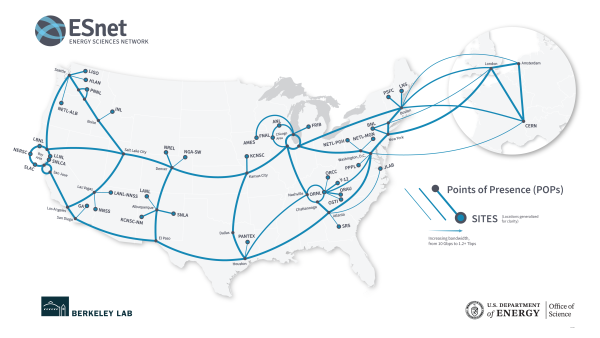About ESnet
A Platform for Accelerating Science Discovery
The Energy Sciences Network (ESnet) is the U.S. Department of Energy’s data circulatory system, provides advanced networking services to the DOE's 17 national laboratories, 28 user facilities (including the four supercomputing facilities), and its major scientific instruments. This high-performance, unclassified network was built to support scientific research. Funded by the DOE's Office of Science (SC) and stewarded by Lawrence Berkeley National Laboratory, ESnet also connects to more than 270 research and commercial networks, permitting DOE-funded scientists to collaborate quickly and productively with global partners.

The map of ESnet6 showing the DOE sites, updated in 2025. Click to enlarge and download larger version; see other map versions.
A Robust Network for Next-Gen Science
Spurred by the growth of large international collaborations in high energy physics, extreme weather research, and genomics, the research community’s needs to manage and transfer large quantities of data are exploding in scope and complexity. Currently, ESnet carries around 150 petabytes of data monthly. Every four years, ESnet's average network traffic increases by a factor of 10. This growth is propelled by the rising tide of data produced by more powerful supercomputers, global collaborations that can involve thousands of researchers, and specialized facilities like the Large Hadron Collider and digital sky surveys.
ESnet6, the most recent generation network, features multiple 400 gigabits per second to 1.2 terabits per second (Tbps) optical channels for more than 57 Tbps of aggregate bandwidth and intelligent network services to support the unique data-intensive needs of scientific research. It also provides 2.7 Tbps of trans-Atlantic capacity via multiple connections.



